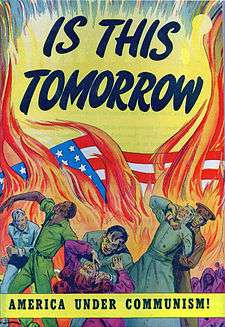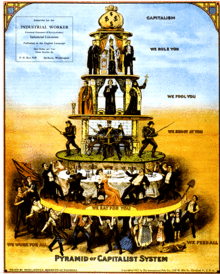Propaganda

.jpg)


Propaganda is "information, especially of a biased or misleading nature, used to promote a political cause or point of view" (Oxford Online Dictionaries[1]). Propaganda is often associated with the psychological mechanisms of influencing and altering the attitude of a population toward a specific cause, position or political agenda in an effort to form a consensus to a standard set of belief patterns.[2]
Propaganda is information that is not impartial and is used primarily to influence an audience and further an agenda, often by presenting facts selectively (perhaps lying by omission) to encourage a particular synthesis, or using loaded messages to produce an emotional rather than a rational response to the information presented.[2]
Today the term propaganda is associated with a manipulative and jingoistic approach, but propaganda historically was a neutral descriptive term.[2][3]
Etymology
Propaganda is a modern Latin word, the gerundive form of propagare, meaning to spread or to propagate, thus propaganda means that which is to be propagated.[4] Originally this word derived from a new administrative body of the Catholic Church (congregation) created in 1622, called the Congregatio de Propaganda Fide (Congregation for Propagating the Faith), or informally simply Propaganda.[3][5] Its activity was aimed at "propagating" the Catholic faith in non-Catholic countries.[3]
From the 1790s, the term began being used also for propaganda in secular activities.[3] The term began taking a pejorative connotation in the mid-19th century, when it was used in the political sphere.[3]
History
Types

Identifying propaganda has always been a problem.[6] The main difficulties have involved differentiating propaganda from other types of persuasion, and avoiding a biased approach ("what they do is propaganda, what we do is education"). Garth Jowett and Victoria O'Donnell have provided a concise, workable definition of the term: "Propaganda is the deliberate, systematic attempt to shape perceptions, manipulate cognitions, and direct behavior to achieve a response that furthers the desired intent of the propagandist."[7] More comprehensive is the description by Richard Alan Nelson: "Propaganda is neutrally defined as a systematic form of purposeful persuasion that attempts to influence the emotions, attitudes, opinions, and actions of specified target audiences for ideological, political or commercial purposes through the controlled transmission of one-sided messages (which may or may not be factual) via mass and direct media channels. A propaganda organization employs propagandists who engage in propagandism—the applied creation and distribution of such forms of persuasion."[8]
Both definitions focus on the communicative process involved — or more precisely, on the purpose of the process, and allow "propaganda" to be considered objectively and then interpreted as positive or negative behavior depending on the perspective of the viewer or listener.
According to historian Zbyněk Zeman, propaganda is defined as either white, grey or black. White propaganda openly discloses its source. Grey propaganda is ambiguous or non-disclosed. Black propaganda purports to be published by the enemy or someone besides its actual origins.[9]
Propaganda shares techniques with advertising and public relations, each of which can be thought of as propaganda that promotes a commercial product or shapes the perception of an organization, person, or brand. In post–World War II usage of the word "propaganda" more typically refers to political or nationalist uses of these techniques or to the promotion of a set of ideas.
Propaganda was often used to influence opinions and beliefs on religious issues, particularly during the split between the Roman Catholic Church and the Protestant churches. Propaganda has become more common in political contexts, in particular to refer to certain efforts sponsored by governments, political groups, but also often covert interests. In the early 20th century, propaganda was exemplified in the form of party slogans. Also in the early 20th century the term propaganda was used by the founders of the nascent public relations industry to refer to their people. This usage died out around the time of World War II, as the industry started to avoid the word, given the pejorative connotation it had acquired.
Literally translated from the Latin gerundive as "things that must be disseminated", in some cultures the term is neutral or even positive, while in others the term has acquired a strong negative connotation. The connotations of the term "propaganda" can also vary over time. For example, in Portuguese and some Spanish language speaking countries, particularly in the Southern Cone, the word "propaganda" usually refers to the most common manipulative media — "advertising".
In English, propaganda was originally a neutral term for the dissemination of information in favor of any given cause. During the 20th century, however, the term acquired a thoroughly negative meaning in western countries, representing the intentional dissemination of often false, but certainly "compelling" claims to support or justify political actions or ideologies. This redefinition arose because both the Soviet Union and Germany's government under Hitler admitted explicitly to using propaganda favoring, respectively, communism and Nazism, in all forms of public expression. As these ideologies were repugnant to liberal western societies, the negative feelings toward them came to be projected into the word "propaganda" itself. However, Harold Lasswell observed, as early as 1928, that, "Propaganda has become an epithet of contempt and hate, and the propagandists have sought protective coloration in such names as 'public relations council,' 'specialist in public education,' 'public relations adviser.' "[10]

Roderick Hindery argues[11] that propaganda exists on the political left, and right, and in mainstream centrist parties. Hindery further argues that debates about most social issues can be productively revisited in the context of asking "what is or is not propaganda?" Not to be overlooked is the link between propaganda, indoctrination, and terrorism/counterterrorism. He argues that threats to destroy are often as socially disruptive as physical devastation itself.
Propaganda also has much in common with public information campaigns by governments, which are intended to encourage or discourage certain forms of behavior (such as wearing seat belts, not smoking, not littering and so forth). Again, the emphasis is more political in propaganda. Propaganda can take the form of leaflets, posters, TV and radio broadcasts and can also extend to any other medium. In the case of the United States, there is also an important legal (imposed by law) distinction between advertising (a type of overt propaganda) and what the Government Accountability Office (GAO), an arm of the United States Congress, refers to as "covert propaganda".
The ease of data collection emerging from the IT revolution and a lack of control on the acquired data's use has led to the widespread implementation of workplace propaganda created much more locally such as in schools, hospitals, local retail outlets and Universities.[12] The same article also notes a departure from the traditional methodology of propagandists i.e., the use of emotionally provocative imagery to distort facts. Workplace propaganda is suggested to use 'distorted data' to overrule emotion. For example, by providing rationales for ideologically driven pay cuts, etc.
Journalistic theory generally holds that news items should be objective, giving the reader an accurate background and analysis of the subject at hand. On the other hand, advertisements evolved from the traditional commercial advertisements to include also a new type in the form of paid articles or broadcasts disguised as news. These generally present an issue in a very subjective and often misleading light, primarily meant to persuade rather than inform. Normally they use only subtle propaganda techniques and not the more obvious ones used in traditional commercial advertisements. If the reader believes that a paid advertisement is in fact a news item, the message the advertiser is trying to communicate will be more easily "believed" or "internalized".
.jpg)
Such advertisements are considered obvious examples of "covert" propaganda because they take on the appearance of objective information rather than the appearance of propaganda, which is misleading. Federal law specifically mandates that any advertisement appearing in the format of a news item must state that the item is in fact a paid advertisement.
The propagandist seeks to change the way people understand an issue or situation for the purpose of changing their actions and expectations in ways that are desirable to the interest group. Propaganda, in this sense, serves as a corollary to censorship in which the same purpose is achieved, not by filling people's minds with approved information, but by preventing people from being confronted with opposing points of view. What sets propaganda apart from other forms of advocacy is the willingness of the propagandist to change people's understanding through deception and confusion rather than persuasion and understanding. The leaders of an organization know the information to be one sided or untrue, but this may not be true for the rank and file members who help to disseminate the propaganda.
Religion

More in line with the religious roots of the term, it is also used widely in the debates about new religious movements (NRMs), both by people who defend them and by people who oppose them. The latter pejoratively call these NRMs cults. Anti-cult activists and Christian countercult activists accuse the leaders of what they consider cults of using propaganda extensively to recruit followers and keep them. Some social scientists, such as the late Jeffrey Hadden, and CESNUR affiliated scholars accuse ex-members of "cults" who became vocal critics and the anti-cult movement of making these unusual religious movements look bad without sufficient reasons.[13][14]
Wartime

Propaganda is a powerful weapon in war; it is used to dehumanize and create hatred toward a supposed enemy, either internal or external, by creating a false image in the mind. This can be done by using derogatory or racist terms, avoiding some words or by making allegations of enemy atrocities. Most propaganda wars require the home population to feel the enemy has inflicted an injustice, which may be fictitious or may be based on facts. The home population must also decide that the cause of their nation is just. In NATO doctrine, propaganda is defined as "Any information, ideas, doctrines, or special appeals disseminated to influence the opinion, emotions, attitudes, or behaviour of any specified group in order to benefit the sponsor either directly or indirectly."[15] Within this perspective, information provided does not need to be necessarily false, but must be instead relevant to specific goals of the "actor" or "system" that performs it.
Propaganda is also one of the methods used in psychological warfare, which may also involve false flag operations. The term propaganda may also refer to false information meant to reinforce the mindsets of people who already believe as the propagandist wishes. The assumption is that, if people believe something false, they will constantly be assailed by doubts. Since these doubts are unpleasant (see cognitive dissonance), people will be eager to have them extinguished, and are therefore receptive to the reassurances of those in power. For this reason propaganda is often addressed to people who are already sympathetic to the agenda. This process of reinforcement uses an individual's predisposition to self-select "agreeable" information sources as a mechanism for maintaining control.
Propaganda can be classified according to the source and nature of the message. White propaganda generally comes from an openly identified source, and is characterized by gentler methods of persuasion, such as standard public relations techniques and one-sided presentation of an argument. Black propaganda is identified as being from one source, but is in fact from another. This is most commonly to disguise the true origins of the propaganda, be it from an enemy country or from an organization with a negative public image. Grey propaganda is propaganda without any identifiable source or author. A major application of grey propaganda is making enemies believe falsehoods using straw arguments: As phase one, to make someone believe "A", one releases as grey propaganda "B", the opposite of "A". In phase two, "B" is discredited using some strawman. The enemy will then assume "A" to be true.
In scale, these different types of propaganda can also be defined by the potential of true and correct information to compete with the propaganda. For example, opposition to white propaganda is often readily found and may slightly discredit the propaganda source. Opposition to grey propaganda, when revealed (often by an inside source), may create some level of public outcry. Opposition to black propaganda is often unavailable and may be dangerous to reveal, because public cognizance of black propaganda tactics and sources would undermine or backfire the very campaign the black propagandist supported.
Propaganda may be administered in insidious ways. For instance, disparaging disinformation about the history of certain groups or foreign countries may be encouraged or tolerated in the educational system. Since few people actually double-check what they learn at school, such disinformation will be repeated by journalists as well as parents, thus reinforcing the idea that the disinformation item is really a "well-known fact", even though no one repeating the myth is able to point to an authoritative source. The disinformation is then recycled in the media and in the educational system, without the need for direct governmental intervention on the media. Such permeating propaganda may be used for political goals: by giving citizens a false impression of the quality or policies of their country, they may be incited to reject certain proposals or certain remarks or ignore the experience of others.
In the Soviet Union during the Second World War, the propaganda designed to encourage civilians was controlled by Stalin, who insisted on a heavy-handed style that educated audiences easily saw was inauthentic. On the other hand, the unofficial rumours about German atrocities were well founded and convincing.[16]
Article 20 of the International Covenant on Civil and Political Rights prohibits any propaganda for war as well as any advocacy of national or religious hatred that constitutes incitement to discrimination, hostility or violence by law.[17]
Since 9/11 and the appearance of greater media fluidity, propaganda institutions, practices and legal frameworks have been evolving in the US and Britain. Dr Emma Louise Briant shows how this included expansion and integration of the apparatus cross-government and details attempts to coordinate the forms of propaganda for foreign and domestic audiences, with new efforts in strategic communication.[18] These were subject to contestation within the US Government, resisted by Pentagon Public Affairs and critiqued by some scholars.[19] The National Defense Authorization Act for Fiscal Year 2013 (section 1078 (a)) amended the US Information and Educational Exchange Act of 1948 (popularly referred to as the Smith-Mundt Act) and the Foreign Relations Authorization Act of 1987, allowing for materials produced by the State Department and the Broadcasting Board of Governors (BBG) to be released within U.S. borders for the Archivist of the United States. The Smith-Mundt Act, as amended, provided that “the Secretary and the Broadcasting Board of Governors shall make available to the Archivist of the United States, for domestic distribution, motion pictures, films, videotapes, and other material 12 years after the initial dissemination of the material abroad (...) Nothing in this section shall be construed to prohibit the Department of State or the Broadcasting Board of Governors from engaging in any medium or form of communication, either directly or indirectly, because a United States domestic audience is or may be thereby exposed to program material, or based on a presumption of such exposure.” Public concerns were raised upon passage due to the relaxation of prohibitions of domestic propaganda in the United States.[20]
Why, of course, the people don't want war. Naturally, the common people don't want war; neither in Russia nor in England nor in America, nor for that matter in Germany. That is understood. the people can always be brought to the bidding of the leaders. That is easy. All you have to do is tell them they are being attacked and denounce the pacifists for lack of patriotism and exposing the country to danger. It works the same way in any country.
Corporate
Corporate propaganda refers to propagandist claims made by a corporation (or corporations), for the purpose of manipulating market opinion with regard to that corporation, and its activities. Just as the use of these products and services theoretically may provide pluses which outweigh the minuses to society and individuals, advocates may poses intentions that some believe may ultimately have a positive impact on society. In reality, however, corporate propaganda is never justified given the relativistic nature of a "plus" or "minus," and the simple fact that it is lying to "free and equal" adults. Sigmund Freud's nephew, Edward Bernays, literally wrote the book (Bernays, Edward (1928). Propaganda. New York: H. Liveright. (See also version of text at website www.historyisaweapon.com: "Propaganda.") on this topic, and was famously open about lack of concern for or respect of the public. Bernays used his clout and paid actors/actresses to stage public events, thus fabricating media, and to manipulate highly visible people into making decisions to benefit whomever employed his services. Together with his Uncle's understanding of human subconscious desires, Bernays developed expert ability to fool people into wanting and buying goods that lacked real function and failed to serve any non-fictional purpose. In fact, despite the now public knowledge of their malevolent origin, many of Bernays' memetic and tactical inventions form the pillars in advertising today (e.g., celebrity spokespersons and falsified but scientific sounding claims), as detailed in the award winning documentary "The Century of the Self".
Common euphemisms for corporate propaganda are advertising and public relations.
Workplace
Workplace propaganda is used by employers directed at employees. Often based upon distorted data utilized to justify ideologically driven decision making processes. This differs from corporate propaganda as it is an internal process and has the potential to be found in small charities as well as in large market driven corporations.
Techniques

Common media for transmitting propaganda messages include news reports, government reports, historical revision, junk science, books, leaflets, movies, radio, television, and posters. Less common nowadays are letter post envelopes examples of which of survive from the time of the American Civil War. (Connecticut Historical Society; Civil War Collections; Covers.) In principle any thing that appears on a poster can be produced on a reduced scale on a pocket-style envelope with corresponding proportions to the poster. The case of radio and television, propaganda can exist on news, current-affairs or talk-show segments, as advertising or public-service announce "spots" or as long-running advertorials. Propaganda campaigns often follow a strategic transmission pattern to indoctrinate the target group. This may begin with a simple transmission such as a leaflet dropped from a plane or an advertisement. Generally these messages will contain directions on how to obtain more information, via a web site, hot line, radio program, etc. (as it is seen also for selling purposes among other goals). The strategy intends to initiate the individual from information recipient to information seeker through reinforcement, and then from information seeker to opinion leader through indoctrination.[21]
A number of techniques based in social psychological research are used to generate propaganda. Many of these same techniques can be found under logical fallacies, since propagandists use arguments that, while sometimes convincing, are not necessarily valid.
Some time has been spent analyzing the means by which the propaganda messages are transmitted. That work is important but it is clear that information dissemination strategies become propaganda strategies only when coupled with propagandistic messages. Identifying these messages is a necessary prerequisite to study the methods by which those messages are spread.
Models
Social psychology
The field of social psychology includes the study of persuasion. Social psychologists can be sociologists or psychologists. The field includes many theories and approaches to understanding persuasion. For example, communication theory points out that people can be persuaded by the communicator's credibility, expertise, trustworthiness, and attractiveness. The elaboration likelihood model as well as heuristic models of persuasion suggest that a number of factors (e.g., the degree of interest of the recipient of the communication), influence the degree to which people allow superficial factors to persuade them. Nobel Prize–winning psychologist Herbert A. Simon won the Nobel prize for his theory that people are cognitive misers. That is, in a society of mass information people are forced to make decisions quickly and often superficially, as opposed to logically.
Social cognitive theories suggest that people have inherent biases in the way they perceive the world and these biases can be used to manipulate them. For example, people tend to believe that people's misfortune (e.g., poverty) is a result of the person and downplay external factors (e.g., being born into poverty). This bias is referred to as the Fundamental Attribution Error. Self Fulfilling prophecies occur when people believe what they have been told they are. Propaganda frequently plays upon people's existing biases to achieve its end. For example, the illusion of control, refers to people's seemingly innate desire to believe they can and should control their lives. Propagandists frequently argue their point by claiming that the other side is attempting to take away your control. For example, Republicans frequently claim that Democrats are attempting to control you by imposing big government on your private life and take away your spending power by imposing higher taxes while Democrats frequently argue that they are reining in big corporations that are attempting to influence elections with money, power and take away your job, health etc. ... According to bipartisan analysis, these claims are frequently untrue.[22]
Herman and Chomsky

The propaganda model is a theory advanced by Edward S. Herman and Noam Chomsky which argues systemic biases in the mass media and seeks to explain them in terms of structural economic causes:
The 20th century has been characterized by three developments of great political importance: the growth of democracy, the growth of corporate power, and the growth of corporate propaganda as a means of protecting corporate power against democracy.[23][24]
First presented in their 1988 book Manufacturing Consent: the Political Economy of the Mass Media, the propaganda model views the private media as businesses selling a product — readers and audiences (rather than news) — to other businesses (advertisers) and relying primarily on government and corporate information and propaganda. The theory postulates five general classes of "filters" that determine the type of news that is presented in news media: Ownership of the medium, the medium's Funding, Sourcing of the news, Flak, and Anti-communist ideology.
The first three (ownership, funding, and sourcing) are generally regarded by the authors as being the most important. Although the model was based mainly on the characterization of United States media, Chomsky and Herman believe the theory is equally applicable to any country that shares the basic economic structure and organizing principles the model postulates as the cause of media bias.
Ross's epistemic merit model

The epistemic merit model is a method for understanding propaganda conceived by Sheryl Tuttle Ross and detailed in her 2002 article for the Journal of Aesthetic Education entitled "Understanding Propaganda: The Epistemic Merit Model and Its Application to Art".[25] Ross developed the Epistemic merit model due to concern about narrow, misleading definitions of propaganda. She contrasted her model with the ideas of Pope Gregory XV, the Institute for Propaganda Analysis, Alfred Lee, F.C. Bartlett, and Hans Speier. Insisting that each of their respective discussions of propaganda are too narrow, Ross proposed her own definition.
To appropriately discuss propaganda, Ross argues that one must consider a threefold communication model: that of Sender-Message-Receiver. "That is... propaganda involve[s]... the one who is persuading (Sender) [who is] doing so intentionally, [the] target for such persuasion (Receiver) and [the] means of reaching that target (Message)." There are four conditions for a message to be considered propaganda. Propaganda involves the intention to persuade. As well, propaganda is sent on behalf of a sociopolitical institution, organization, or cause. Next, the recipient of propaganda is a socially significant group of people. Finally, propaganda is an epistemic struggle to challenge others' thoughts.
Ross claims that it is misleading to say that propaganda is simply false, or that it is conditional to a lie, since often the propagandist believes in what he/she is propagandizing. In other words, it is not necessarily a lie if the person who creates the propaganda is trying to persuade you of a view that they actually hold. "The aim of the propagandist is to create the semblance of credibility." This means that they appeal to an epistemology that is weak or defective.
False statements, bad arguments, immoral commands as well as inapt metaphors (and other literary tropes) are the sorts of things that are epistemically defective... Not only does epistemic defectiveness more accurately describe how propaganda endeavors to function... since many messages are in forms such as commands that do not admit to truth-values, [but it] also accounts for the role context plays in the workings of propaganda.
Throughout history those who have wished to persuade have used art to get their message out. This can be accomplished by hiring artists for the express aim of propagandizing or by investing new meanings to a previously non-political work. Therefore, Ross states, it is important to consider "the conditions of its making [and] the conditions of its use."
Children
.jpg)

Of all the potential targets for propaganda, children are the most vulnerable because they are the least prepared with the critical reasoning and contextual comprehension they need to determine whether a message is propaganda or not. Children's vulnerability to propaganda is rooted in developmental psychology. The attention children give their environment during development, due to the process of developing their understanding of the world, causes them to absorb propaganda indiscriminately. Also, children are highly imitative: studies by Albert Bandura, Dorothea Ross and Sheila A. Ross in the 1960s indicated that, to a degree, socialization, formal education and standardized television programming can be seen as using propaganda for the purpose of indoctrination. The use of propaganda in schools was highly prevalent during the 1930s and 1940s in Germany, as well as in Stalinist Russia.
Anti-Semitic propaganda for children
In Nazi Germany, the education system was thoroughly co-opted to indoctrinate the German youth with anti-Semitic ideology. This was accomplished through the National Socialist Teachers League, of which 97% of all German teachers were members in 1937. The League encouraged the teaching of racial theory. Picture books for children such as Don't Trust A Fox in A Green Meadow or The Word of A Jew, Der Giftpilz (translated into English as The Poisonous Mushroom) and The Poodle-Pug-Dachshund-Pincher were widely circulated (over 100,000 copies of Don't Trust A Fox... were circulated during the late 1930s) and contained depictions of Jews as devils, child molesters and other morally charged figures. Slogans such as "Judas the Jew betrayed Jesus the German to the Jews" were recited in class.[26] The following is an example of a propagandistic math problem recommended by the National Socialist Essence of Education: "The Jews are aliens in Germany—in 1933 there were 66,606,000 inhabitants in the German Reich, of whom 499,682 (.75%) were Jews."[27]
See also
Notes
- ↑ "propaganda - definition of propaganda in English". Oxford Dictionaries Online. Retrieved October 27, 2016.
- 1 2 3 Smith, Bruce L. (February 17, 2016). "Propaganda". britannica.com. Encyclopædia Britannica, Inc. Retrieved April 23, 2016.
- 1 2 3 4 5 Diggs-Brown, Barbara (2011) Strategic Public Relations: Audience Focused Practice p. 48
- ↑ Oxford dictionary.
- ↑ "Online Etymology Dictionary". Retrieved 6 March 2015.
- ↑ Daniel J Schwindt, The Case Against the Modern World: A Crash Course in Traditionalist Thought, 2016, pp. 202–204.
- ↑ Garth Jowett and Victoria O'Donnell (2006), Propaganda and Persuasion, 4th ed. Sage Publications, p. 7
- ↑ Richard Alan Nelson, A Chronology and Glossary of Propaganda in the United States (1996) pp. 232–233
- ↑ Zeman, Zbynek (1978). Selling the War. Orbis Publishing. ISBN 0-85613-312-4.
- ↑ pp. 260–261, "The Function of the Propagandist", International Journal of Ethics, 38 (no. 3): pp. 258–268.
- ↑ Hindery, Roderick R., Indoctrination and Self-deception or Free and Critical Thought? (2001)
- ↑ McNamara, Adam. "BULL: A new form of propaganda in the digital age.". Retrieved 5 August 2015.
- ↑ "The Religious Movements Page: Conceptualizing "Cult" and "Sect"". Archived from the original on 2006-02-07. Retrieved December 4, 2005.
- ↑ "Polish Anti-Cult Movement (Koscianska) - CESNUR". Retrieved December 4, 2005.
- ↑ North Atlantic Treaty Organization, Nato Standardization Agency Aap-6 - Glossary of terms and definitions, p 188.
- ↑ Karel C. Berkhoff, Motherland in Danger: Soviet Propaganda during World War II (2012) excerpt and text search
- ↑ "International Covenant on Civil and Political Rights". United Nations Human Rights: Office of the High Commissioner for Human Rights. United Nations. Retrieved 2 Sep 2015.
- ↑ Briant (April 2015). "Allies and Audiences Evolving Strategies in Defense and Intelligence Propaganda". The International Journal of Press/Politics. 20 (2): 145–165.
- ↑ Briant, Emma (2015). Propaganda and Counter-terrorism: strategies for global change. Manchester: Manchester University Press.
- ↑ "Smith-Mundt Act". 'Anti-Propaganda' Ban Repealed, Freeing State Dept. To Direct Its Broadcasting Arm At American Citizens. Techdirt. Retrieved 1 Jun 2016.
- ↑ Garth S. Jowett and Victoria J.: O'Donnell, Propaganda & Persuasion (5th ed. 2011)
- ↑ "FactCheck.org". FactCheck.org. Retrieved 6 March 2015.
- ↑ "Letter from Noam Chomsky" to Covert Action Quarterly, quoting Alex Carey, Australian social scientist, http://mediafilter.org/caq/CAQ54chmky.html
- ↑ "Review of Alex Carey, Taking the Risk out of Democracy: Propaganda in the US and Australia". Retrieved 6 March 2015.
- ↑ Ross, Sheryl Tuttle. "Understanding Propaganda: The Epistemic Merit Model and Its Application to Art." Journal of Aesthetic Education, Vol. 36, No.1. pp. 16–30
- ↑ Mills, Mary. "Propaganda and Children During the Hitler Years". Jewish Virtual Library. https://www.jewishvirtuallibrary.org/jsource/Holocaust/propchil.html
- ↑ Hirsch, Herbert. Genocide and the Politics of Memory. Chapel Hill & London: University of North Carolina Press, 1995. p. 119.
References
- "Appendix I: PSYOP Techniques". Psychological Operations Field Manual No. 33-1. Washington, D.C.: Department of the Army. August 31, 1979.
- Bytwerk, Randall L. (2004). Bending Spines: The Propagandas of Nazi Germany and the German Democratic Republic. East Lansing: Michigan State University Press. ISBN 0-87013-710-7.
- Edwards, John Carver (1991). Berlin Calling: American Broadcasters in Service to the Third Reich. New York: Praeger. ISBN 0-275-93905-7.
- Hindery, Roderick. "The Anatomy of Propaganda within Religious Terrorism". Humanist (March–April 2003): 16–19.
- Howe, Ellic (1982). The Black Game: British Subversive Operations Against the German During the Second World War. London: Futura.
- Huxley, Aldous (1958). Brave New World Revisited. New York: Harper. ISBN 0-06-080984-1.
- Jowett, Garth S.; O'Donnell, Victoria (2006). Propaganda and Persuasion (4th ed.). Thousand Oaks, California: Sage Publications, Inc. ISBN 1-4129-0897-3.
- Le Bon, Gustave (1895). The Crowd: A Study of the Popular Mind. ISBN 0-14-004531-7.
- Linebarger, Paul M. A. (1948). Psychological Warfare. Washington, D.C.: Infantry Journal Press. ISBN 0-405-04755-X.
- Nelson, Richard Alan (1996). A Chronology and Glossary of Propaganda in the United States. Westport, CT: Greenwood Press. ISBN 0-313-29261-2.
- Shirer, William L. (1942). Berlin Diary: The Journal of a Foreign Correspondent, 1934–1941. New York: Albert A. Knopf. ISBN 5-9524-0081-7.
- Young, Emma (October 10, 2001). "Psychological warfare waged in Afghanistan". New Scientist. Archived from the original on 2002-02-13. Retrieved 2010-08-05.
Further reading
Books
- Altheide, David L. & Johnson, John M. Bureaucratic Propaganda. Boston: Allyn and Bacon, Inc. (1980)
- Bernays, Edward (1928). Propaganda. New York: H. Liveright. (See also version of text at website www.historyisaweapon.com: "Propaganda.")
- Brown, J.A.C. Techniques of Persuasion: From Propaganda to Brainwashing Harmondsworth: Pelican (1963)
- Chomsky, Noam and Herman, Edward. Manufacturing Consent: The Political Economy of the Mass Media. New York: Pantheon Books. (1988)
- Cole, Robert. Propaganda in Twentieth Century War and Politics (1996)
- Cole, Robert, ed. Encyclopedia of Propaganda (3 vol 1998)
- Combs, James E. & Nimmo, Dan. The New Propaganda: The Dictatorship of Palaver in Contemporary Politics. White Plains, N.Y. Longman. (1993)
- Cull, Nicholas John, Culbert, and Welch, eds. Propaganda and Mass Persuasion: A Historical Encyclopedia, 1500 to the Present (2003)
- Cunningham, Stanley, B. The Idea of Propaganda: A Reconstruction. Westport, Conn.: Praeger. (2002)
- Cunninghamm Stanley B. "Reflections on the Interface Between Propaganda and Religion." In P.Rennick, S. Cunningham, R.H. Johnson (eds), The Future of Religion. Cambridge Scholars Pub.: Newcastle upon Tyne 2010, pp. 83–96.
- Dimitri Kitsikis, Propagande et pressions en politique internationale, Paris, Presses Universitaires de France, 1963, 537 pages.
- Ellul, Jacques. Propaganda: The Formation of Men's Attitudes. Trans. Konrad Kellen & Jean Lerner. New York: Knopf, 1965. New York: Random House/ Vintage 1973
- Jowett, Garth S. and Victoria O"Donnell, 'Propaganda and Persuasion, 6th edition. ' California: Sage Publications, 2014. A detailed overview of the history, function, and analyses of propaganda.
- Marlin, Randal. Propaganda & The Ethics of Persuasion. Orchard Park, New York: Broadview Press. (2002)
- McCombs M. E. & Shaw, D. L. (1972). The agenda-setting function of mass media. Public Opinion Quarterly, 36, 176–187.
- Moran, T. "Propaganda as Pseudocommunication." Et Cetera 2(1979), pp. 181–197.
- Pratkanis, Anthony & Aronson, Elliot. Age of Propaganda: The Everyday Use and Abuse of Persuasion. New York: W.H. Freeman and Company. (1992)
- Rutherford, Paul. Endless Propaganda: The Advertising of Public Goods. Toronto: University of Toronto Press. (2000)
- Rutherford, Paul. Weapons of Mass Persuasion: Marketing the War Against Iraq. Toronto: University of Toronto Press. (2004)
- Shaw, Jeffrey M. Illusions of Freedom: Thomas Merton and Jacques Ellul on Technology and the Human Condition. Eugene, OR: Wipf and Stock. ISBN 978-1625640581 (2014)
- Sproule, J. Michael. Channels of Propaganda. Bloomington, IN: EDINFO Press. (1994)
- Stauber, John, and Rampton, Sheldon Toxic Sludge Is Good for You! Lies, Damn Lies and the Public Relations Industry Monroe, Maine: Common Courage Press, 1995.
Essays/Articles
- Brown, John H.. "Two Ways of Looking at Propaganda" (2006)
- Kosar, Kevin R., Public Relations and Propaganda: Restrictions on Executive Branch Activities, CRS Report RL32750, February 2005.
| Wikimedia Commons has media related to Propaganda. |
| Wikiquote has quotations related to: Propaganda |
